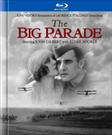|
|
||||
|
|
by Adam Hakari  War had been depicted on film before 1925's The Big Parade, but not quite like the way that movie pulled it off. King Vidor's epic production was released when wounds left by the First World War were still fresh in the public consciousness, bringing with it a rather balanced view of what had transpired. Vidor neither glorified combat nor used it as the backdrop for a more fanciful story. Instead, he presented the great battle through a protagonist with no particular political leanings. The Big Parade merely shows what happens when one is faced with the fight firsthand, capturing with equal amounts of realism and theatricality the allure of enlistment and the harsh reality soon experienced afterwards. Silent screen icon John Gilbert plays Jim Apperson, a wealthy young man with no real aspirations to speak of. With a job in the family business and engagement to the beautiful Justyn Reed (Claire Adams) practically set in stone, Jim basically has his life all planned out. That is, until America officially becomes involved in World War I, after which our lad joins the Armed Forces to further earn Justyn's admiration. Promptly assigned to a small French village to await further orders, Jim bides his time by romancing a local girl, Melisande (Renee Adoree). But what begins as simple flirtation blooms into a bona fide love affair, one whose strength gets tested when Jim is at last summoned to the battlefield. If D.W. Griffith's The Birth of a Nation is credited as the first work of silent cinema to elevate it to an art form taken seriously, then you could say The Big Parade is one of its swan songs. The film came out just a few short years before sound took the industry by storm, yet it remains remarkably proficient in terms of its storytelling and technical aspects. This motion picture carries an undeniable power that's only enhanced by the absence of spoken dialogue, an ideal example of visuals and expressive acting saying everything that needs to be said. Even its most memorable scenes contain only a modicum of musical accompaniment; the gloomy march Jim takes to the front lines, as fellow troops fall victim to snipers behind him, owes its suspenseful nature to the soundtrack's eerie calm. Also, while many of The Big Parade's images will be familiar to anyone who's seen at least a couple of war dramas, the movie avoids feeling cliched thanks Vidor's insistence on authenticity. Because of the incredible job this filmmaker does in maintaining a "you are there" atmosphere, you'd never tell the dirty trenches in which Jim and company find themselves huddled were actually shot in locations like the legendary Griffith Park. Because Vidor broaches all of his subjects with a sure hand, The Big Parade effectively tells two stories at once. Never does it come across as a romance that would've been just fine if it weren't for that pesky World War, and neither does it mash your face in a melodramatic display of despair. It simply boils down to seeing the world through Jim's eyes and understanding his reactions, which Vidor executes with little effort. Gilbert's Jim may appear too passive for some, but that's because the character's development isn't emphasized too strongly or weighed down with weary tropes. He's just a guy learning that the world can be a rough, rough place, and Gilbert's performance reflects this subtlety to a tee. Likewise, Adoree's turn as Melisande is feisty and heartfelt, a lively lass you can believe would swoon over Jim, rather than a soulless love interest who exists only because the script demands one. Even Karl Dane and Tom O'Brien, who portray Jim's colorful army buddies, also manage to sidestep the pitfall of caricature, thereby endearing themselves to the viewer. Newly restored by Warner Bros. for its Blu-ray debut, The Big Parade still impresses and awes after almost 90 years. In focusing on emotion and tenderness over pryotechnics, the film achieves a relatability that helps it stand toe-to-toe with the grittiest of recent war stories. Though the prospect of watching a two-and-a-half hour silent movie may seem daunting as all get-out, The Big Parade is sturdy enough to grip you regardless of its length. Warner Bros.' The Big Parade Blu-ray contains the following special features: -Digibook packaging, featuring 64 pages of art, press materials, and various notes by film historian Kevin Brownlow. -Feature commentary with film historian Jeffrey Vance, with excerpts from a previously recorded interview with director King Vidor sprinkled throughout. While a little dry at times, it's an informative and insightful track; one of the more interesting tidbits shared by Vidor is his inspiration for the film's famous march scene being a military funeral procession. -1925 Studio Tour, a 32-minute look back in time that tours the massive MGM lot. -The Big Parade's theatrical trailer. |
||
|
© 2025 - ReelTalk Movie Reviews Website designed by Dot Pitch Studios, LLC |



